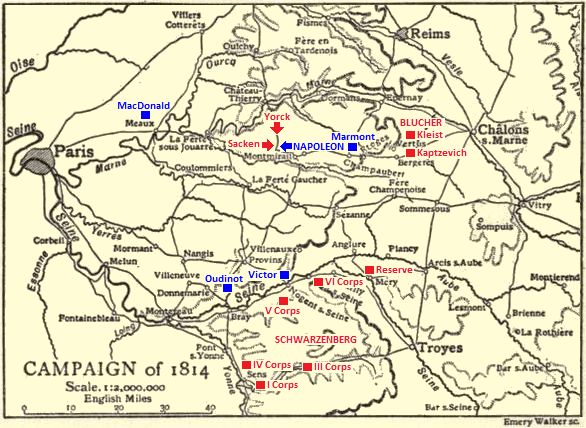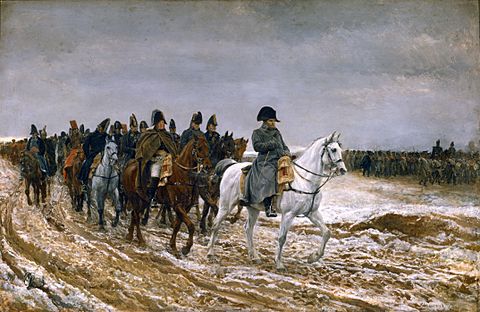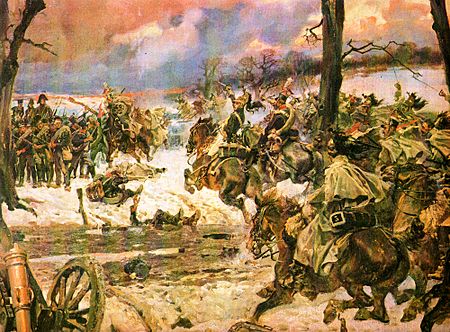Battle of Montmirail facts for kids
Quick facts for kids Battle of Montmirail |
|||||||
|---|---|---|---|---|---|---|---|
| Part of the Campaign of France of the Sixth Coalition | |||||||
 Battle of Montmirail by Horace Vernet |
|||||||
|
|||||||
| Belligerents | |||||||
| Commanders and leaders | |||||||
| Strength | |||||||
| 20,000–25,000 | Russia: 18,000, 90 guns Prussia: 9,000, 16 guns Total: 27,000–39,000 106 guns |
||||||
| Casualties and losses | |||||||
| 2,000–2,100 | Russia: 2,800, 9–26 guns Prussia: 900 Total casualties: 3,700–4,000, 9–26 guns |
||||||
The Battle of Montmirail was a major fight during the Napoleonic Wars. It happened on February 11, 1814, near Montmirail, France. In this battle, the French army, led by Emperor Napoleon, fought against two groups of Allied soldiers. These Allied groups were commanded by Fabian Wilhelm von Osten-Sacken from Russia and Ludwig Yorck von Wartenburg from Prussia.
The battle was very tough and lasted all day. Napoleon's French troops, including his best soldiers called the Imperial Guard, managed to defeat Sacken's Russian forces. The Russians were forced to retreat north. A part of Yorck's Prussian army tried to help, but they were also pushed back. However, their arrival helped distract the French long enough for Sacken's Russians to escape and join them in their retreat. This battle was part of the Six Days Campaign, where Napoleon tried to defend France from the invading Allied armies. The next day, Napoleon continued his pursuit in the Battle of Château-Thierry.
Contents
Why Did the Battle of Montmirail Happen?
The War of the Sixth Coalition
In early 1814, Napoleon's French Empire was fighting against a large group of European countries known as the Sixth Coalition. These countries included Russia, Prussia, Austria, and Great Britain. They had invaded France, hoping to defeat Napoleon once and for all.
Allied Armies Advance on France
Two main Allied armies were moving towards Paris. One was the Army of Bohemia, led by Austrian Field Marshal Karl Philipp, Prince of Schwarzenberg. The other was the Army of Silesia, led by Prussian Field Marshal Gebhard Leberecht von Blücher. On February 1, 1814, these Allied armies, with about 80,000 soldiers, defeated Napoleon's 45,000 French troops at the Battle of La Rothière.
After this victory, the Allies planned to march on Paris. Schwarzenberg's army moved from Troyes, and Blücher's army moved from Châlons-sur-Marne. However, the Allied armies spread out too much. Blücher, thinking the war was almost over, pushed ahead quickly. He didn't realize that a dangerous gap had opened up between his army and Schwarzenberg's.
Napoleon's Plan to Strike Back
Napoleon learned that Blücher's army was heading for Paris. He knew his own forces were too weak to stop them directly. So, he decided to attack Blücher's army while it was spread out. He sent out patrols to find out exactly where Blücher's different groups of soldiers were.
On February 9, Napoleon found out that Fabian Wilhelm von Osten-Sacken was near Montmirail with about 15,000 troops. He also knew that Ludwig Yorck von Wartenburg was nearby with 18,000 men. Napoleon saw a chance to defeat these parts of Blücher's army one by one.
French Forces Gather
Napoleon had about 70,000 soldiers in total to face the 200,000 Allied troops. He decided to focus his main attack on Blücher, who he thought had about 45,000 soldiers. Napoleon gathered a strong force of 30,000 men and 120 cannons. This force included his best troops, like the Imperial Guard.
On February 10, Napoleon's army attacked a smaller Russian group of 5,000 soldiers led by Zakhar Dmitrievich Olsufiev at the Battle of Champaubert. Olsufiev's troops were almost completely destroyed, and he was captured. This victory put Napoleon right in the middle of Blücher's spread-out army.
The Battle of Montmirail Begins
Allied Movements Before the Fight
When Blücher heard that Olsufiev's troops were defeated, he ordered his other commanders, Kleist and Kaptzevich, to march back. He also told Yorck to go to Montmirail but to keep the important bridge over the Marne River at Château-Thierry safe for a possible retreat.
Sacken, who was further west, was told to march east to Montmirail to meet Yorck. Sacken destroyed a bridge behind him to prevent the French from following. However, Blücher didn't tell Sacken about using the Marne River for escape.
Napoleon's Bold Plan
Napoleon quickly moved his main army west to destroy Sacken's forces. He left a smaller group to watch Blücher. Napoleon ordered his cavalry to capture Montmirail first, followed by his infantry. He hoped to defeat Sacken and Yorck while they were separated from Blücher.
Yorck sent a message to Sacken, saying his Prussian soldiers were too tired to join him quickly. Yorck suggested Sacken retreat north to Château-Thierry. Sacken, however, decided to follow his orders and try to fight his way east through Montmirail. He didn't know how strong Napoleon's army was.
At the start of the battle, Napoleon had fewer soldiers than Sacken. He had about 5,000 Old Guard infantry, 4,500 cavalry, and one infantry division, with 36 cannons. It was a huge risk for Napoleon, as he wasn't sure if his own reinforcements or Yorck's Prussians would arrive first.
The Armies Face Off
Sacken's Russian army had about 18,000 soldiers and 90 cannons. Yorck's Prussian army had about 9,000 soldiers and 16 cannons, but many of their heavy cannons were left behind because of the muddy roads.
Napoleon's forces grew to about 20,000 to 25,000 men during the battle. His army included elite units like the Imperial Guard cavalry and infantry.
The battlefield was mostly rolling hills with several woods. The Petit Morin River flowed along the southern edge. Napoleon placed his troops to block the main east-west highway and the road to Château-Thierry, trying to prevent Sacken and Yorck from joining up.
The Fight for Marchais
Around 11:00 am, a group of Russian soldiers captured the village of Marchais-en-Brie. Napoleon ordered his troops to attack Marchais at noon. A fierce fight for the village lasted for two hours, but the Russians held on.
Napoleon then ordered an artillery bombardment and waited for more of his Old Guard soldiers to arrive. At 2:00 pm, he launched an attack on Sacken's left side. French cavalry and infantry pushed back the Russian first line. Sacken had to use his second line and move his cavalry to try and connect with Yorck's Prussians.
French cavalry charges broke some Russian formations, forcing them into the woods. However, Russian cavalry fought back, pushing the French horsemen away and keeping the link with the Prussians. The fight for Marchais continued, with the village changing hands several times.
Prussians Arrive and the Battle Continues
Around 3:00 pm, the first Prussian troops from Yorck's army arrived. They had only lighter cannons because of the muddy roads. Yorck was worried about French forces appearing behind him, so he sent some of his infantry back to hold Château-Thierry.
The Prussians attacked towards some woods, supported by Russian cannons. At the same time, more of Napoleon's Old Guard division arrived and joined the fight against Yorck. Napoleon sent more troops to attack Marchais. The French eventually captured the village around 5:00 pm.
As the Russians retreated from Marchais, French cavalry charged them, causing heavy losses. Some Russian soldiers were cut down or captured. Sacken realized that without Marchais, the battle was lost, so he began to pull back his cannons. Russian infantry formed squares to defend against French cavalry charges, and their own cavalry helped them escape.
The Prussians also faced strong French attacks. Despite support from Russian artillery, the Prussian attack was met with heavy gunfire. One Prussian general, Pirch, was badly wounded. The Prussians continued to retreat.
As evening fell, Napoleon's Polish Lancers pushed far west. Sacken's army was almost trapped, but Yorck's efforts had bought them enough time to escape. With their cavalry covering them, the Russians retreated towards Château-Thierry in the rain. They marched all night through marshes and woods, guided by bonfires. They managed to save most of their cannons, but eight damaged ones were left behind.
What Was the Outcome of the Battle?
The Battle of Montmirail was a clear victory for Napoleon. The French army lost about 2,000 soldiers. The Allied forces suffered much heavier losses, with about 2,000 Russians killed or wounded and 800 captured. The Prussians lost another 900 soldiers. In total, the Allies lost between 3,700 and 4,000 men, plus some cannons.
Napoleon's victory at Montmirail was important because he managed to defeat parts of Blücher's army while they were separated. This showed Napoleon's skill as a military leader, even when his empire was struggling.
The next day, Napoleon continued to chase Sacken and Yorck's retreating armies. This led to the Battle of Château-Thierry on February 12. Napoleon hoped to trap the Allied forces against the Marne River. He took a calculated risk, believing that Schwarzenberg's army would move slowly, giving him time to deal with Blücher's forces.







